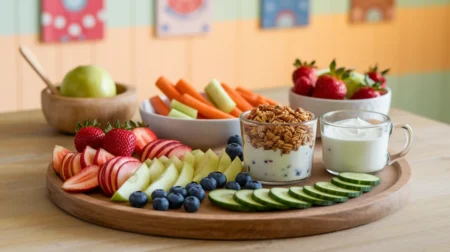As a busy woman, it can be challenging to prioritize your health and make sustainable choices when it comes to eating. However, with the right strategies and mindset, incorporating healthy eating into your daily routine is not only achievable but also essential for your overall well-being.
In this article, we will explore quick and practical tips to help you eat healthy, change your eating habits, and navigate the confusion surrounding healthy eating. Whether you’re a high-achieving woman looking to fuel your success or simply want to improve your relationship with food, we have the answers.
We understand that being really busy can make it difficult to focus on yourself and your health. That’s why our goal is to provide actionable advice to help you eat healthy without feeling restricted or overwhelmed by your busy schedule. We want to help high-performing women like you succeed not just in work, but in taking care of yourself too.
Throughout this article, we will address common challenges faced by busy women, such as emotional eating and the struggle to stop overeating. We’ll provide practical strategies to establish a healthy relationship with food and offer tips to eat healthy and lose weight effectively, even when you have a lot on your plate.
So, if you’re ready to prioritize your health and make positive changes, this article is for you. Let’s dive in and discover how to become a naturally healthy eater, despite your busy lifestyle.
Key Takeaways:
- Incorporating healthy eating into a busy lifestyle is possible with the right strategies and mindset.
- Changing your eating habits is essential for long-term success and weight loss.
- Understanding healthy eating confusion is crucial to becoming a naturally healthy eater.
- Busy women can eat healthy without feeling restricted or overwhelmed.
- Establishing a healthy relationship with food is the key to maintaining a balanced approach to eating.
Understanding Healthy Eating for Busy Women
As a busy woman, it’s important to understand what healthy eating truly means. With so much information out there, it’s easy to get confused by different diets and conflicting advice. But don’t worry, we’re here to debunk common misconceptions and help you become a naturally healthy eater without feeling restricted.
“Healthy eating is not about depriving yourself or following strict rules. It’s about nourishing your body with the right nutrients and enjoying a balanced lifestyle.”
Contrary to popular belief, healthy eating doesn’t have to be complicated or overwhelming. By making small, sustainable changes to your eating habits, you can achieve long-term success without feeling restricted.
Debunking Healthy Eating Confusion
Let’s address some of the common healthy eating confusion:
- Myth: Healthy eating means cutting out all carbs or fats. In reality, your body needs carbohydrates and fats for energy and essential functions. The key is to choose the right sources and consume them in moderation.
- Myth: Healthy eating is time-consuming and requires cooking everything from scratch. While cooking meals from scratch can be beneficial, there are plenty of healthy options that are quick and convenient. It’s all about making mindful choices.
- Myth: Healthy eating is expensive. Eating healthy doesn’t have to break the bank. By planning meals, buying in season, and opting for whole foods, you can nourish your body without spending a fortune.
Now that we’ve cleared up some confusion, let’s dive into the steps to becoming a naturally healthy eater without feeling restricted.
| Steps to Becoming a Naturally Healthy Eater | Description |
|---|---|
| 1. Focus on whole, nutrient-dense foods. | Fill your plate with fruits, vegetables, lean proteins, whole grains, and healthy fats. These foods provide essential nutrients and keep you satisfied. |
| 2. Listen to your body’s hunger and fullness cues. | Eat when you’re hungry and stop when you’re satisfied. Pay attention to how different foods make you feel, both physically and emotionally. |
| 3. Practice mindful eating. | Avoid distractions while eating, such as screens or work. Take the time to savor your meals, chew slowly, and appreciate the flavors. |
| 4. Find healthy swaps for your favorite indulgences. | You don’t have to give up your favorite treats entirely. Look for healthier alternatives or find ways to enjoy them in moderation. |
| 5. Build a support system. | Surround yourself with like-minded individuals who are also on a journey to healthier eating. Share recipes, tips, and support each other along the way. |
By following these steps, you can transition into a naturally healthy eater and enjoy the benefits of a balanced diet without feeling restricted or overwhelmed.
Changing Your Eating Habits
When it comes to achieving your weight loss goals and maintaining a healthy lifestyle, changing your eating habits is essential. By making small, sustainable changes to the way you eat, you can eat healthy and lose weight without feeling deprived. Here are some practical strategies to help you get started:
1. Plan your meals
Planning your meals in advance can greatly assist in changing your eating habits. By knowing what you’ll eat ahead of time, you can make healthier choices and avoid impulsive decisions. Create a weekly meal plan and prepare your meals in advance to save time and stay on track.
2. Incorporate more fruits and vegetables
Increasing your intake of fruits and vegetables is an excellent way to eat healthy and lose weight. These nutrient-dense foods provide essential vitamins, minerals, and fiber while being low in calories. Aim to fill half your plate with colorful fruits and vegetables at each meal.
3. Practice mindful eating
Mindful eating involves paying attention to your body’s hunger and fullness cues, eating slowly, and savoring each bite. By being more present during meals, you can better regulate your food intake and develop a healthier relationship with food.
4. Cut back on processed foods
Processed foods are often high in added sugars, unhealthy fats, and sodium, which can contribute to weight gain and negatively impact your health. Minimize your intake of processed foods and opt for whole, unprocessed alternatives whenever possible.
5. Control portion sizes
Monitoring portion sizes is crucial for managing your calorie intake and reaching your weight loss goals. Use smaller plates and bowls to help control portion sizes, and be mindful of serving sizes recommended on food labels.
6. Stay hydrated
Drinking plenty of water can help curb your appetite, prevent overeating, and support your overall health. Aim to drink at least eight glasses of water per day and limit your intake of sugary beverages.
7. Seek support
Changing your eating habits is easier when you have a support system in place. Reach out to friends, family, or join a community or online group focusing on healthy eating and weight loss. Sharing your journey with others can provide motivation, accountability, and helpful tips.
By incorporating these strategies into your daily routine, you can gradually change your eating habits and achieve your weight loss goals while maintaining your busy schedule. Remember, consistency is key, and making small, sustainable changes will lead to long-term success.
| Benefits of Changing Your Eating Habits |
|---|
| 1. Weight Loss: Changing your eating habits can help you achieve and maintain a healthy weight. |
| 2. Improved Energy Levels: Eating healthy foods can boost your energy levels and enhance overall well-being. |
| 3. Reduced Risk of Chronic Diseases: A nutritious diet can lower the risk of chronic conditions such as heart disease, diabetes, and certain cancers. |
| 4. Better Digestive Health: Eating a balanced diet rich in fiber can promote good digestive health and prevent digestive issues. |
| 5. Enhanced Mental Clarity: Proper nutrition can improve cognitive function and mental clarity, allowing you to perform at your best. |
Overcoming Healthy Eating Challenges for Busy Women
As a busy woman, it’s understandable that healthy eating may sometimes feel like a daunting task. Between work, family, and other responsibilities, finding the time and energy to prioritize your nutrition can be a challenge. However, by addressing specific challenges and implementing simple strategies, you can overcome these hurdles and make healthy eating a top priority in your life.
Finding Time to Eat
When you’re really busy, it’s easy to skip meals or grab quick, unhealthy snacks on the go. However, it’s important to carve out dedicated time for eating nutritious meals. Here are some tips:
- Create a meal plan: Plan your meals ahead of time to ensure you have healthy options readily available.
- Meal prep: Spend a few hours on the weekends to prepare nutritious meals and snacks for the week.
- Take breaks: Schedule regular breaks throughout the day to step away from work and enjoy a nourishing meal.
Dealing with Emotional Eating
Emotional eating can often be a challenge for busy women who are juggling multiple responsibilities. Here are some strategies to help you navigate emotional eating:
- Identify triggers: Pay attention to the emotions that lead to emotional eating and find healthier ways to cope with them.
- Practice mindful eating: Slow down, savor your food, and pay attention to your body’s hunger and fullness cues.
- Seek support: Reach out to friends, family, or a therapist for support in dealing with emotional eating behaviors.
Making Healthy Eating a Priority
It’s important to prioritize your health and well-being, even when life gets busy. Here are some tips to help you make healthy eating a top priority:
“Your health is an investment, and nourishing your body with wholesome foods will provide long-term benefits.”
- Set realistic goals: Break your healthy eating goals into smaller, achievable steps.
- Practice self-care: Prioritize activities that nurture your physical, mental, and emotional well-being.
- Seek accountability: Find a friend or accountability partner who can support and motivate you on your healthy eating journey.
| Challenge | Strategy |
|---|---|
| Finding Time to Eat | Create a meal plan, meal prep, and take breaks throughout the day. |
| Dealing with Emotional Eating | Identify triggers, practice mindful eating, and seek support from others. |
| Making Healthy Eating a Priority | Set realistic goals, prioritize self-care, and seek accountability. |
By implementing these strategies and making small changes, you can overcome the challenges of healthy eating as a busy woman. Remember to be kind to yourself and celebrate your progress along the way. Prioritizing your health is not only beneficial for your well-being but also for your ability to thrive in all areas of your life.
Establishing a Healthy Relationship with Food
Developing a positive and healthy relationship with food is essential for long-term success. Many of us have experienced emotional eating at some point in our lives, using food to cope with stress, sadness, or other emotions. However, by understanding the impact of emotional eating and taking steps to develop a balanced approach to food, you can gain control over your eating habits and prioritize your overall well-being.
Overcoming Emotional Eating
Emotional eating often occurs when we try to soothe our emotions with food, using it as a temporary escape or comfort. It’s essential to recognize and address emotional triggers to establish a healthy relationship with food. Here are a few strategies to help you overcome emotional eating:
- Identify emotional triggers: Pay attention to the emotions that may lead to overeating or unhealthy food choices. Keeping a journal or seeking therapy can help you identify and understand these triggers.
- Cultivate alternative coping mechanisms: Find healthy ways to manage your emotions, such as exercise, practicing mindfulness or meditation, engaging in hobbies, or seeking support from loved ones.
- Practice mindful eating: Pay attention to your body’s hunger and fullness cues while eating. Slow down and savor each bite, focusing on the taste, texture, and aroma of the food.
A Balanced Approach to Food
Adopting a balanced approach to food can help you establish a healthy relationship and make sustainable choices. Here are some key tips:
“Food is fuel for the body, but it is also a source of pleasure and enjoyment. Finding a balance between nourishing your body and enjoying the foods you love is key to developing a healthy relationship with food.”
- Focus on nutrient-dense foods: Incorporate a variety of fruits, vegetables, whole grains, lean proteins, and healthy fats into your diet to ensure you are getting the nutrients your body needs.
- Allow for occasional indulgences: Restricting yourself from the foods you love can lead to feelings of deprivation. Allow yourself occasional treats in moderation to maintain a healthy relationship with food.
- Listen to your body: Pay attention to your body’s cues of hunger and fullness. Eat when you’re hungry and stop when you’re satisfied. Avoid rigid dieting rules or strict meal plans that may disconnect you from your body’s natural signals.
By overcoming emotional eating and adopting a balanced approach to food, you can establish a healthy relationship that promotes overall well-being. Remember, everyone’s journey is unique, and finding what works best for you may take time. Be patient with yourself and seek support from professionals if needed. Prioritizing your relationship with food is an empowering step towards a healthier and happier you.
Practical Tips for Eating Healthy on the Go
When you’re really busy, finding time to eat healthy can feel like an impossible task. However, with the right strategies and meal ideas, you can eat healthy without feeling restricted, even when you’re on the go.
Here are some practical tips and time-saving solutions that will help you prioritize your health:
- Plan and prep your meals: Spend some time each week planning and prepping your meals. This will save you time and ensure that you have healthy options readily available. Consider preparing grab-and-go meals such as salads in mason jars or pre-portioned snacks like cut-up fruits and veggies.
- Choose healthy options at restaurants: When dining out, opt for restaurants that offer healthier choices. Look for dishes that are grilled, steamed, or roasted instead of fried. Choose options that are rich in lean proteins, whole grains, and vegetables.
- Stock up on nutritious snacks: Keep your pantry, desk, or bag stocked with nutritious snacks that you can easily grab when hunger strikes. Some great options include nuts, seeds, Greek yogurt, whole grain crackers, or homemade protein bars.
- Utilize meal delivery services: Consider using meal delivery services that specialize in providing healthy and balanced meals. These services often have options for specific dietary preferences and can be a convenient way to ensure you’re eating well even when you’re short on time.
- Stay hydrated: It’s easy to forget to drink enough water when you’re busy, but staying hydrated is crucial for overall health. Keep a reusable water bottle with you at all times and aim to drink at least 8 cups of water per day.
Remember, eating healthy on the go doesn’t have to be complicated. By implementing these practical tips and making small, sustainable changes to your eating habits, you can prioritize your health and well-being even when you’re really busy.
Nutritional Tips for High-Achieving Women
As a high-achieving woman, it’s easy to prioritize everything else in your life except your own health. However, taking care of yourself is crucial for long-term success. By prioritizing healthy eating, you can enhance your energy, focus, and overall well-being. Here are some essential nutritional tips specifically tailored to meet the needs of high-performing women:
- Prioritize nutrient-rich foods: Make sure to include a variety of fruits, vegetables, lean proteins, whole grains, and healthy fats in your diet. These foods provide the essential vitamins, minerals, and antioxidants your body needs to thrive.
- Plan and prepare meals ahead of time: With a packed schedule, it’s easy to resort to unhealthy fast food or skipping meals altogether. To avoid this, dedicate time each week to plan and prepare nutritious meals in advance. This will help you stay on track with your healthy eating goals.
- Stay hydrated: Drinking enough water is essential for maintaining optimal health and productivity. Carry a reusable water bottle with you throughout the day to stay hydrated and prevent dehydration, which can negatively impact your energy levels.
- Manage stress and emotional eating: High-achieving women often face high levels of stress, which can lead to emotional eating. Find healthy ways to manage stress, such as practicing mindfulness, engaging in physical activity, or seeking support from a therapist. This can help you develop a healthier relationship with food.
- Listen to your body: Pay attention to your hunger and fullness cues. Eat when you’re hungry and stop when you’re satisfied. Listening to your body’s signals can prevent overeating and promote a healthier eating pattern.
Remember, prioritizing your health and well-being is not a luxury but a necessity. By incorporating these nutritional tips into your busy life, you can thrive both personally and professionally.
“Taking care of yourself doesn’t mean me first, it means me too.” – L.R. Knost
| Nutritional Tip | Description |
|---|---|
| Prioritize nutrient-rich foods | Incorporate a variety of fruits, vegetables, lean proteins, whole grains, and healthy fats into your diet for essential nutrients. |
| Plan and prepare meals ahead of time | Dedicate time each week to plan and prepare nutritious meals in advance to avoid unhealthy food choices. |
| Stay hydrated | Carry a reusable water bottle and drink enough water throughout the day to stay hydrated and maintain energy levels. |
| Manage stress and emotional eating | Find healthy ways to manage stress and emotional eating, such as practicing mindfulness or seeking support from a therapist. |
| Listen to your body | Pay attention to your hunger and fullness cues to prevent overeating and establish a healthier eating pattern. |
Overcoming Overeating and Food Cravings
If you struggle with overeating and food cravings, you’re not alone. Many busy women find themselves caught in a cycle of emotional eating and an unhealthy relationship with food. But there is hope! By understanding the underlying causes and implementing practical strategies, you can regain control over your eating habits and develop a healthier approach to food.
Recognizing Emotional Eating
Emotional eating is often a response to stress, boredom, or other emotions rather than true hunger. It’s important to identify the triggers that lead to emotional eating so you can find alternative ways to cope with your emotions. Keep a food diary to track your emotions and the foods you eat, which can help you pinpoint patterns and make positive changes.
Developing Healthy Coping Strategies
Instead of turning to food when faced with emotions, find alternative coping mechanisms that truly nourish your soul. Engage in activities such as exercise, journaling, meditation, or spending time with loved ones. These healthy coping strategies can help break the cycle of emotional eating and provide a more fulfilling outlet for your emotions.
Creating a Mindful Eating Practice
Mindful eating is about being present in the moment and fully experiencing your food. Slow down and savor each bite, paying attention to the flavors, textures, and sensations. This practice can help you become more aware of your body’s hunger and fullness cues, preventing overeating and promoting a healthier relationship with food.
Building Balanced Meals
Avoid restrictive diets that can lead to feelings of deprivation and trigger overeating. Instead, focus on building balanced meals that include a variety of nutrient-dense foods. Include protein, healthy fats, and fiber in each meal to keep you satisfied and prevent cravings. Planning your meals ahead of time can also help you make healthier choices throughout the day.
Seeking Support
Remember, you don’t have to overcome overeating and food cravings alone. Reach out to a healthcare professional or therapist who specializes in disordered eating or emotional eating. They can provide guidance, support, and personalized strategies to help you break free from the cycle of overeating and develop a healthier relationship with food.
| Practical Tips to Overcome Overeating and Food Cravings |
|---|
| 1. Keep a food diary to track emotions and eating patterns. |
| 2. Find alternative coping mechanisms like exercise, journaling, or meditation. |
| 3. Practice mindful eating by savoring each bite and listening to your body’s cues. |
| 4. Build balanced meals with protein, healthy fats, and fiber. |
| 5. Seek support from a healthcare professional or therapist. |
Strategies for Sustainable Weight Loss
Achieving sustainable weight loss can be a challenge for busy women. When juggling numerous responsibilities and a jam-packed schedule, it’s easy to overlook healthy eating and prioritize convenience over nutrition. However, with the right strategies and a commitment to prioritize healthy eating, you can achieve your weight loss goals without sacrificing your overall well-being.
1. Make Time for Meal Planning
Meal planning is a crucial component of sustainable weight loss. Set aside time each week to plan your meals and snacks. This will help you make healthier choices and avoid impulsive, unhealthy food options when you’re pressed for time. By having nutritious meals and snacks readily available, you’ll be less tempted to reach for unhealthy alternatives.
2. Focus on Whole, Nutrient-Dense Foods
When it comes to weight loss, prioritize whole, nutrient-dense foods. These foods are rich in vitamins, minerals, and fiber, providing essential nutrients while keeping you satisfied. Include plenty of fruits, vegetables, lean proteins, whole grains, and healthy fats in your diet. Avoid processed and sugary foods that provide empty calories and hinder your weight loss efforts.
3. Portion Control and Mindful Eating
Portion control plays a significant role in weight management. Be mindful of your portion sizes and listen to your body’s hunger and fullness cues. Practice mindful eating by slowing down, savoring each bite, and paying attention to the sensations of hunger and fullness. This will help you develop a healthy relationship with food and prevent overeating.
“Eating too quickly can lead to overeating as the brain doesn’t have enough time to register feelings of fullness.”
4. Stay Hydrated
Drinking an adequate amount of water throughout the day can support weight loss. Water helps boost metabolism, suppresses appetite, and aids in digestion. Carry a reusable water bottle with you, and aim to drink at least eight glasses of water per day.
5. Incorporate Physical Activity
In addition to healthy eating, regular physical activity is essential for sustainable weight loss. Find activities that you enjoy and make them a part of your daily routine. Whether it’s brisk walking, yoga, or dancing, find ways to stay active and burn calories.
6. Seek Support and Accountability
Enlist the support of friends, family, or a weight loss group to keep you accountable and motivated on your weight loss journey. Having a support system in place can provide encouragement, valuable advice, and help you stay on track.
7. Monitor Your Progress
Track your progress by monitoring your weight, measurements, and how your clothes fit. Remember that weight loss is a gradual process, and there may be ups and downs along the way. Celebrate your achievements, no matter how small, and stay focused on your long-term goals.
8. Practice Self-Care
Lastly, prioritize self-care to support your weight loss efforts. Stress, lack of sleep, and emotional eating can derail your progress. Prioritize activities that help you relax, reduce stress, and nurture your overall well-being. This can include activities such as meditation, journaling, practicing gratitude, or engaging in hobbies you enjoy.
By implementing these strategies, you can achieve sustainable weight loss and prioritize healthy eating as a busy woman. Remember that everyone’s weight loss journey is unique, and it’s important to listen to your body’s needs and make choices that align with your overall health and well-being.
Prioritizing Self-Care for Successful Healthy Eating
When it comes to maintaining healthy eating habits, prioritizing self-care is key. Taking care of yourself not only supports your physical well-being but also helps you navigate emotional eating triggers. By creating a supportive environment and focusing on your emotional needs, you can set yourself up for successful healthy eating.
Self-care helps you prioritize healthy eating by:
- Reducing stress levels: Stress can often lead to emotional eating, making it harder to stick to a healthy eating plan. By practicing self-care activities like meditation or yoga, you can effectively manage stress and reduce the likelihood of turning to food for comfort.
- Practicing mindful eating: Self-care involves being present in the moment, even while eating. By practicing mindful eating, you can develop a deeper connection with your food and enhance your awareness of hunger and fullness cues. This can help you make better choices and avoid overeating.
- Setting boundaries: As a busy woman, it’s important to prioritize yourself and set boundaries when it comes to your time and energy. By saying no to excessive commitments and carving out time for self-care activities, you can create a supportive environment that allows you to focus on your health and well-being.
- Engaging in self-reflection: Take the time to reflect on your relationship with food and identify any emotional eating patterns. This self-awareness can help you understand the underlying emotions that trigger unhealthy eating habits. By addressing these emotions through self-care practices like journaling or seeking support from a therapist, you can develop healthier coping mechanisms.
“Self-care is not selfish. You cannot serve from an empty vessel.” – Eleanor Brownn
Remember, prioritizing self-care is not selfish. It is a necessary step in your journey towards successful healthy eating. By taking care of yourself, you can better manage emotional eating, make informed food choices, and nurture a positive relationship with food.
Tips and Resources for Busy Women
As a busy woman, maintaining a healthy eating routine is essential for your overall well-being. To help you on your journey, we have curated a list of tips, tools, and resources that are specifically tailored to meet the needs of really busy women who want to prioritize their health through healthy eating.
1. Meal Planning Made Easy
One of the most effective ways to ensure you eat healthy is by planning your meals in advance. With the multitude of responsibilities you manage, meal planning can save you time and stress. Consider using meal planning apps and websites that offer customizable meal plans and grocery lists. These tools can be a game-changer for busy women looking to make healthy eating a top priority.
2. Quick and Nutritious Recipes
When you’re crunched for time, it’s important to have a collection of quick and nutritious recipes at your fingertips. Look for cookbooks or websites that offer simple, healthy recipes that can be prepared in under 30 minutes. Having a repertoire of go-to meals will make healthy eating more accessible and enjoyable.
3. Snacks On-the-Go
Being really busy often means you’re constantly on the move. To avoid reaching for unhealthy snacks when hunger strikes, stock up on nutritious, portable options. Keep a stash of pre-portioned nuts, seeds, protein bars, and fresh fruits in your bag or desk drawer. Having these convenient snacks readily available will help you make better choices when you’re pressed for time.
4. Meal Delivery Services
If finding time to cook is a struggle, consider subscribing to a meal delivery service that offers healthy, pre-portioned meals. These services provide ready-made meals that can be customized to your dietary preferences and delivered right to your doorstep. It takes the guesswork out of meal planning and ensures you have nourishing options available even on your busiest days.
5. Fitness and Nutrition Apps
Take advantage of technology by using fitness and nutrition apps to track your progress and stay motivated. There are a variety of apps available that can help you set goals, monitor your food intake, track workouts, and offer personalized guidance. Find an app that aligns with your needs and preferences to make healthy eating and weight management even more convenient and enjoyable.
6. Online Communities and Support Groups
Connecting with like-minded individuals can provide valuable support and accountability on your healthy eating journey. Join online communities or support groups where you can share your experiences, seek guidance, and find inspiration. These networks can be great sources of motivation when the going gets tough and can help you stay committed to your health goals.
7. Mindfulness and Stress-Relief Techniques
Managing stress and taking care of your mental well-being is just as important as eating healthy. Incorporate mindfulness and stress-relief techniques into your routine, such as meditation, deep breathing exercises, or yoga. These practices can help you cultivate a healthier relationship with food and reduce emotional eating tendencies.
8. Educational Resources
Stay informed and educated about healthy eating and weight management through books, podcasts, documentaries, and reputable websites. The more knowledge you have, the better equipped you will be to make informed choices and navigate the world of nutrition. Seek out evidence-based resources that provide reliable information and stay away from fad diets or misinformation.
9. Time Management Strategies
Effectively managing your time is key to fitting healthy eating into your busy schedule. Utilize time management techniques, such as setting priorities, delegating tasks, and creating a structured daily routine. By aligning your schedule with your health goals, you can ensure you have dedicated time for meal planning, grocery shopping, and cooking.
By incorporating these tips and utilizing the resources available to you, you can successfully prioritize your health through healthy eating, even with a busy lifestyle. Remember, making small changes and staying consistent is the key to achieving long-term success!
Conclusion
Incorporating healthy eating into your busy lifestyle as a woman is achievable with the right strategies and mindset. By implementing the tips and advice provided in this article, you can simplify your nutrition and achieve your health and wellness goals. Remember to prioritize your own well-being, as it is essential for long-term success.
Changing your eating habits may seem challenging, but with dedication and practical strategies, you can make sustainable changes. Overcoming any confusion surrounding healthy eating is key to becoming a naturally healthy eater, free from unnecessary restrictions.
Challenges such as a busy schedule and emotional eating can hinder your progress, but it’s important to prioritize healthy eating and find ways to address these obstacles. Establishing a healthy relationship with food and overcoming overeating and food cravings are crucial steps toward achieving your goals.
For high-achieving women, it’s essential to prioritize your own health. Nutritional tips tailored specifically to your needs can help you maintain a balanced approach while pursuing your ambitious goals. Finally, remember to practice self-care, as it plays a vital role in maintaining healthy eating habits and overall well-being.
FAQ
What is healthy eating for busy women?
Healthy eating for busy women refers to maintaining a balanced diet and making nutritious food choices despite having a hectic schedule. It involves incorporating whole foods, choosing nutrient-dense options, and finding practical solutions to eat well even when time is limited.
How can I change my eating habits without feeling restricted?
Changing eating habits doesn’t have to be about restriction. Start by making small, sustainable changes, such as adding more fruits and vegetables to your meals or swapping unhealthy snacks for healthier alternatives. Focus on nourishing your body and finding enjoyment in the process rather than feeling deprived.
What are some common misconceptions about healthy eating?
One common misconception is that healthy eating is boring and tasteless. In reality, there are countless delicious and nutritious options available. Another misconception is that healthy eating requires strict diets or eliminating certain food groups. Healthy eating is about balance and moderation, not extreme restriction.
How can I prioritize healthy eating when I’m really busy?
Busy women can prioritize healthy eating by planning ahead, meal prepping, and finding time-saving solutions. This may include batch cooking, utilizing healthy meal delivery services, or incorporating quick and nutritious snacks into your routine. It’s all about finding strategies that work for you and your schedule.
How can I establish a healthy relationship with food?
Developing a healthy relationship with food involves practicing mindful eating, listening to your body’s hunger and fullness cues, and cultivating self-compassion. It’s important to view food as nourishment rather than punishment, and to find a balance between indulgence and nourishment.
What are some practical tips for eating healthy on the go?
When you’re busy and on the go, opt for portable and convenient options like pre-cut fruits and vegetables, nutrient-packed smoothies, or homemade trail mix. It’s also helpful to have healthy snacks readily available, such as nuts, seeds, or protein bars. Planning and preparation are key.
How can high-achieving women prioritize their health through healthy eating?
High-achieving women can prioritize their health by recognizing the importance of self-care and making it a non-negotiable part of their routine. This includes setting boundaries, carving out time for meal planning and preparation, and making conscious food choices that support their well-being.
How can I overcome overeating and food cravings?
Overcoming overeating and food cravings starts with understanding the underlying triggers. Practice mindful eating, identify emotional triggers, and find healthier alternatives to satisfy cravings. Cultivate self-awareness and seek support if needed from a healthcare professional or a certified health coach.
What strategies can I adopt for sustainable weight loss?
Sustainable weight loss involves making long-term lifestyle changes rather than relying on short-term diets. Focus on incorporating whole foods, increasing physical activity, and finding a sustainable balance between calorie intake and expenditure. Seek professional guidance to create an individualized plan that fits your needs.
How does prioritizing self-care contribute to successful healthy eating?
Prioritizing self-care helps reduce stress levels, promotes a positive mindset, and enhances overall well-being. When you prioritize self-care, you’re more likely to make healthier food choices and maintain consistent healthy eating habits. Remember to prioritize yourself and your needs amidst your busy schedule.
Where can I find additional tips and resources for healthy eating as a busy woman?
You can find additional tips, tools, and resources by listening to the “Eating for Busy Women” podcast by Kat Rentas. Kat’s specialty is helping high-performing women work through their unique food challenges and develop a naturally healthy relationship with food. You can also visit Kat Rentas’ website and explore her coaching programs for more guidance and support.










